Restoring synaptic plasticity and memory in mouse models of Alzheimer's disease by PKR inhibition
- PMID: 29233183
- PMCID: PMC5727890
- DOI: 10.1186/s13041-017-0338-3
Restoring synaptic plasticity and memory in mouse models of Alzheimer's disease by PKR inhibition
Abstract
Alzheimer's disease (AD) is a neurodegenerative disorder associated with deficits in cognition and synaptic plasticity. While accumulation of amyloid β (Aβ) and hyper-phosphorylation of tau are parts of the etiology, AD can be caused by a large number of different genetic mutations and other unknown factors. Considering such a heterogeneous nature of AD, it would be desirable to develop treatment strategies that can improve memory irrespective of the individual causes. Reducing the phosphorylation of eukaryotic translation initiation factor 2α (eIF2α) was shown to enhance long-term memory and synaptic plasticity in naïve mice. Moreover, hyper-phosphorylation of eIF2α is observed in the brains of postmortem AD patients. Therefore, regulating eIF2α phosphorylation can be a plausible candidate for restoring memory in AD by targeting memory-enhancing mechanism. In this study, we examined whether PKR inhibition can rescue synaptic and learning deficits in two different AD mouse models; 5XFAD transgenic and Aβ1-42-injected mice. We found that the acute treatment of PKR inhibitor (PKRi) can restore the deficits in long-term memory and long-term potentiation (LTP) in both mouse models without affecting the Aβ load in the hippocampus. Our results prove the principle that targeting memory enhancing mechanisms can be a valid candidate for developing AD treatment.
Keywords: Alzheimer’s disease (AD); Amyloid β (Aβ); Contextual fear conditioning; Long-term potentiation (LTP); Object recognition memory; PKR inhibitor (PKRi).
Conflict of interest statement
Ethics approval
All the animal experiments were approved by the Seoul National University Institutional Animal Care and Use Committee (SNU IACUC) and the Chung-Ang University Institutional Animal Care and Use Committee (CAU IACUC).
Consent for publication
Not applicable.
Competing interests
The authors declare no conflict of interest.
Publisher’s Note
Springer Nature remains neutral with regard to jurisdictional claims in published maps and institutional affiliations.
Figures
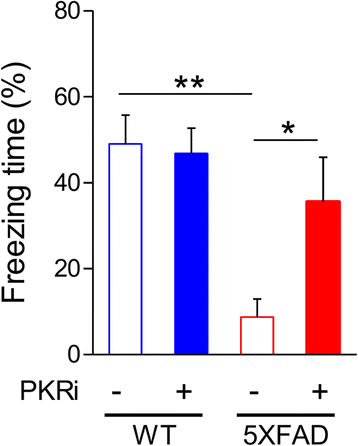
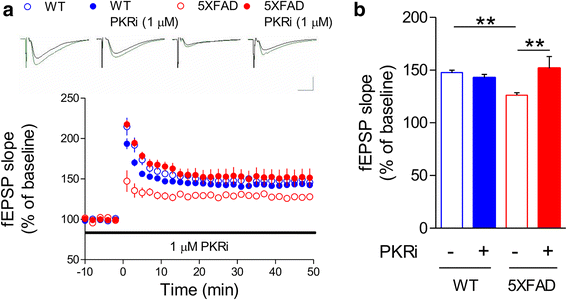
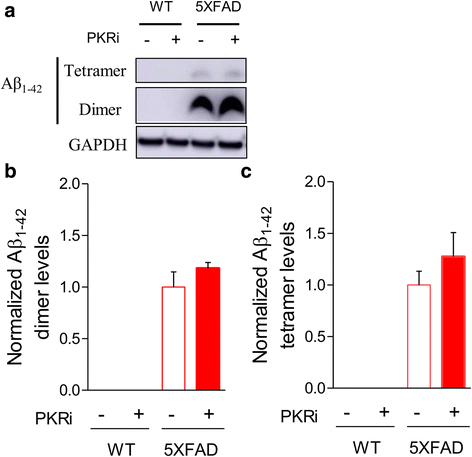
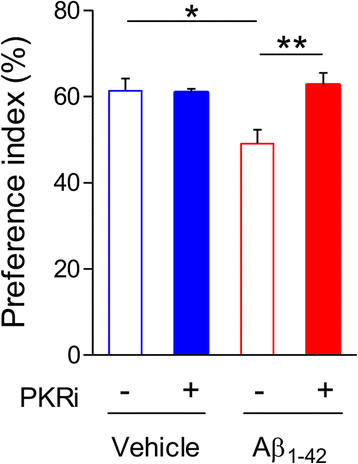
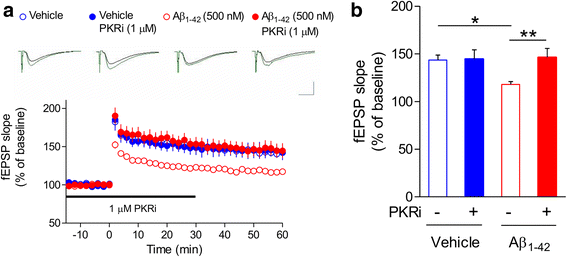
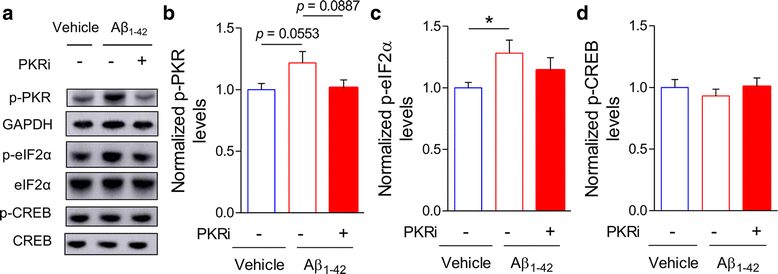
Similar articles
-
The flavonoid baicalein rescues synaptic plasticity and memory deficits in a mouse model of Alzheimer's disease.Behav Brain Res. 2016 Sep 15;311:309-321. doi: 10.1016/j.bbr.2016.05.052. Epub 2016 May 24. Behav Brain Res. 2016. PMID: 27233830
-
Reducing Ribosomal Protein S6 Kinase 1 Expression Improves Spatial Memory and Synaptic Plasticity in a Mouse Model of Alzheimer's Disease.J Neurosci. 2015 Oct 14;35(41):14042-56. doi: 10.1523/JNEUROSCI.2781-15.2015. J Neurosci. 2015. PMID: 26468204 Free PMC article.
-
Repression of the eIF2α kinase PERK alleviates mGluR-LTD impairments in a mouse model of Alzheimer's disease.Neurobiol Aging. 2016 May;41:19-24. doi: 10.1016/j.neurobiolaging.2016.02.005. Epub 2016 Feb 13. Neurobiol Aging. 2016. PMID: 27103515 Free PMC article.
-
[Effects of amyloid β-protein on hippocampal long-term potentiation].Sheng Li Xue Bao. 2010 Dec 25;62(6):479-88. Sheng Li Xue Bao. 2010. PMID: 21170492 Review. Chinese.
-
PKR involvement in Alzheimer's disease.Alzheimers Res Ther. 2017 Oct 5;9(1):83. doi: 10.1186/s13195-017-0308-0. Alzheimers Res Ther. 2017. PMID: 28982375 Free PMC article. Review.
Cited by
-
Fingolimod mitigates memory loss in a mouse model of Gulf War Illness amid decreasing the activation of microglia, protein kinase R, and NFκB.Neurotoxicology. 2023 May;96:197-206. doi: 10.1016/j.neuro.2023.05.006. Epub 2023 May 7. Neurotoxicology. 2023. PMID: 37160207 Free PMC article.
-
Patient-derived tau and amyloid-β facilitate long-term depression in vivo: role of tumour necrosis factor-α and the integrated stress response.Brain Commun. 2024 Sep 27;6(5):fcae333. doi: 10.1093/braincomms/fcae333. eCollection 2024. Brain Commun. 2024. PMID: 39391333 Free PMC article.
-
Comparison of memory, affective behavior, and neuropathology in APPNLGF knock-in mice to 5xFAD and APP/PS1 mice.Behav Brain Res. 2021 Apr 23;404:113192. doi: 10.1016/j.bbr.2021.113192. Epub 2021 Feb 16. Behav Brain Res. 2021. PMID: 33607163 Free PMC article.
-
The integrated stress response in brain diseases: A double-edged sword for proteostasis and synapses.Curr Opin Neurobiol. 2024 Aug;87:102886. doi: 10.1016/j.conb.2024.102886. Epub 2024 Jun 19. Curr Opin Neurobiol. 2024. PMID: 38901329 Free PMC article. Review.
-
APOE4 confers transcriptomic and functional alterations to primary mouse microglia.Neurobiol Dis. 2022 Mar;164:105615. doi: 10.1016/j.nbd.2022.105615. Epub 2022 Jan 11. Neurobiol Dis. 2022. PMID: 35031484 Free PMC article.
References
MeSH terms
Substances
Grants and funding
LinkOut - more resources
Full Text Sources
Other Literature Sources
Medical
Molecular Biology Databases

